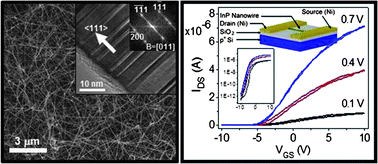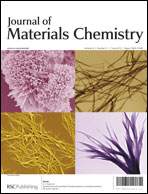High-performance indium phosphide nanowires synthesized on amorphous substrates: from formation mechanism to optical and electrical transport measurements†
Abstract
InP NWs have been extensively explored for next-generation electronic and optoelectronic devices due to their excellent carrier mobility, exciton lifetime and wave-guiding characteristics. Typically, those NWs are grown epitaxially on crystalline substrates which could limit their potential applications requiring high growth yield to be printable or transferable on amorphous and flexible substrates. Here, utilizing Au as catalytic seeds, we successfully demonstrate the synthesis of crystalline, stoichiometric and dense InP NWs on amorphous substrates. Notably, the NWs are found to grow via the vapor–liquid–solid (VLS) mechanism with a narrow distribution of diameter (34.6 ± 7.7 nm) uniformly along the entire NW length (>10 μm). Although the grown NWs possess a substantial amount of twin defects, the fabricated NW FETs still exhibit impressive electrical performance with high carrier mobility (∼350 cm2 V−1 s−1) and ION/IOFF ratio (∼106). All these have demonstrated the promising potency of such NWs grown on amorphous substrates for technological applications, as compared to the conventional MBE or


 Please wait while we load your content...
Please wait while we load your content...